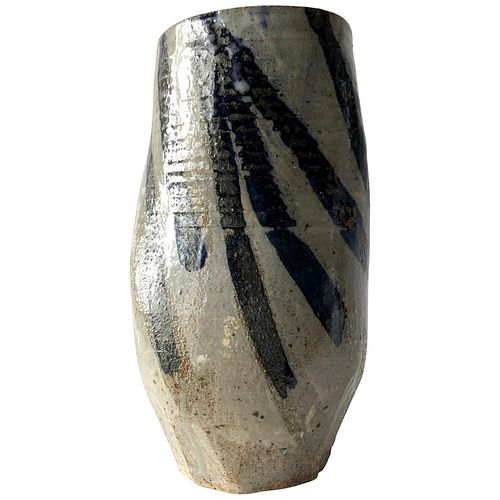John Mason California Studio Stoneware Pottery Vase
About Seller
, CA 91105
United States
Lisa Cliff's experience is over 25 years of collecting the finest examples of vintage modernist design. It includes sculpture, ceramics, glass, textiles, furnishings and fine art with a studied and expert focus on original Post War studio jewelry. Lisa sells to collectors around the globe.
About Auction
Dec 17, 2020 - Dec 31, 2020
Lisa Cliff Collection lisa@lisacliff.com
- Lot Description
California studio pottery vase created by John Mason of Carlsbad, California. Vase form measures 10" by 5.5". Signed Mason on the bottom. In very good vintage condition. John Mason is shown in my last photo in his downtown L.A. studio in 1997. Photo: Al Seib / Los Angeles Times. The following was taken from the Frank Lloyd Gallery, with thanks: John Mason (1927-2019) was an important figure in American sculpture, particularly that of the West Coast. Born in Madrid, Nebraska in 1927 and raised in Fallon, Nevada, Mason moved to Los Angeles in 1949 at the age of 22. He first enrolled at the Los Angeles Art Institute (now Otis) and then studied with Susan Peterson at the Chouinard Art Institute. In 1954, the Los Angeles Art Institute hired Peter Voulkos to head the ceramics department. Mason worked with Voulkos and others in the ceramics studios at night, and worked independently during the day. By 1957, Mason and Voulkos moved to a new studio that they shared on Glendale Blvd. During the period of 1957-1965, Mason focused on exploring the physical properties of clay‰ÛÓits possibilities as well as its limitations as a medium. He constantly experimented with his material‰Ûªs plasticity, pushing clay to its technical limits and developing innovative firing techniques. The artist then diversified his output, producing tall vertical sculptures, huge wall reliefs, cross forms and geometric shapes. Symmetry, rotation, mass, and the integration of color and form came to characterize his work, and are some of the sustaining concepts of his career. Although Mason does not consciously draw on identifiable sources in his work, he does recall an interest in primitive art, a fact which is manifested in the mysterious and totemic quality of many of his pieces. Mason's work over the past six decades presents one of the most compelling arguments for abstract sculpture. His line of thought and consistency of execution are the hallmarks of a true artist, motivated by his desire to push his creative explorations even further. Suzanne Muchnic, writing for ArtNews, describes his position in the art world thusly; ‰ÛÏA major figure in ceramic sculpture, Mason emerged in the mid-1950s as one of the leaders of a revolution that transformed clay from a craft to a fine art medium‰Û_ In his latest work, Mason has proved himself a master builder and sculptor who knows how to get the most out of a relatively simple three dimensional form.‰Û John Mason‰Ûªs innovations in the field of ceramic sculpture opened the art world‰Ûªs eyes to the possibilities of the medium. His process-based method of working emphasized the clay and what he could do with it, as he pushed to material well past conventional limits and tradition. John Coplans illustrates this point, writing, ‰ÛÏhe is not only capable of endowing his massive images with a rich complexity of associative values, but in helping to free ceramics from its long tradition of vessel form and intimate scale he has persuasively demonstrated the flexibility of a hitherto limited material.‰Û Since the late 1950s, when he exhibited at the legendary Ferus Gallery, Mason has had one-man shows at the Pasadena Museum of Art (1960 and 1974), the Los Angeles County Museum (1966), the San Francisco Museum of Modern Art (1978), and the Hudson River Museum (1978), among others. His work is represented in numerous major museum collections, including the Norton Simon Museum of Art, Pasadena, the Museum of Contemporary Art, Los Angeles, the Metropolitan Museum of Art, New York, and the Los Angeles County Museum of Art.Wear consistent with age and use. Very good vintage condition.
Condition
- Shipping Info
-
Shipping is the responsibility of the purchaser. Upon request, our staff will provide a list of shippers who deliver to destinations within the United States and overseas. Some property that is sold can be subject to laws governing export from the U.S. Import restrictions from foreign countries are subject to these same governing laws. Granting of licensing for import or export of goods from local authorities is the sole responsibility of the buyer. Denial or delay of licensing will not constitute cancellation or delay in payment for the total purchase price of these items.
-



 EUR
EUR CAD
CAD AUD
AUD GBP
GBP MXN
MXN HKD
HKD CNY
CNY MYR
MYR SEK
SEK SGD
SGD CHF
CHF THB
THB



















